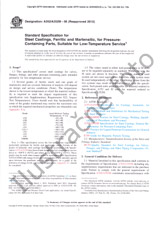Potrebujeme váš súhlas na využitie jednotlivých dát, aby sa vám okrem iného mohli ukazovať informácie týkajúce sa vašich záujmov. Súhlas udelíte kliknutím na tlačidlo „OK“.
ASTM E3277-21
Standard Test Method for Determining Whether a Material is a Liquid or a Solid by Rheometry
NORMA vydaná dňa 1.3.2021
Informácie o norme:
Označenie normy: ASTM E3277-21
Poznámka: NEPLATNÁ
Dátum vydania normy: 1.3.2021
Kód tovaru: NS-1022881
Počet strán: 3
Približná hmotnosť: 9 g (0.02 libier)
Krajina: Americká technická norma
Kategória: Technické normy ASTM
Anotácia textu normy ASTM E3277-21 :
Keywords:
dynamic mechanical analysis, gel point, liquid, rheometry, solid,, ICS Number Code 17.060 (Measurement of volume, mass, density, viscosity)
Doplňujúce informácie
| Significance and Use |
|
5.1?Shipping regulations often require the identification of a material as either a liquid or a solid. This test method may be used to make that determination for regulatory purposes. 5.2?For liquid thermosetting resin, as cure progresses, the liquid resin becomes a solid. A thermosetting resin is more easily worked or shaped while in the liquid-like form and becomes more difficult to do so as the cure advances. The point at which the solid-like character becomes dominant is called the gel point and is considered to be the end of the period where the thermosetting resin is workable. Gel point is identified as that point where tan ? = 1 as determined in Test Method D4473. Note 1:?Gel point at ambient temperature is seldom a useful
parameter. Use of this test method at the more useful elevated
temperatures requires capabilities readily available but outside of
7.2.6, 7.2.7, and Section 10.
5.3?This test method may be used in research, development, and for regulatory compliance. |
| 1. Scope |
|
1.1?Using rheometry, this test method determines, for regulatory purposes, whether a viscose viscous material is a liquid or a solid. Very small amounts of material (typical less than 3 g) may be used for this measurement. 1.2?The values stated in SI units are to be regarded as standard. No other units of measurement are included in this standard. 1.3?This standard does not purport to address all of the safety concerns, if any, associated with its use. It is the responsibility of the user of this standard to establish appropriate safety, health, and environmental practices and determine the applicability of regulatory limitations prior to use. 1.4?This international standard was developed in accordance with internationally recognized principles on standardization established in the Decision on Principles for the Development of International Standards, Guides and Recommendations issued by the World Trade Organization Technical Barriers to Trade (TBT) Committee. |
Odporúčame:
Aktualizácia technických noriem
Chcete mať istotu, že používate len platné technické normy?
Ponúkame Vám riešenie, ktoré Vám zaistí mesačný prehľad o aktuálnosti noriem, ktoré používate.
Chcete vedieť viac informácií ? Pozrite sa na túto stránku.




 Cookies
Cookies
